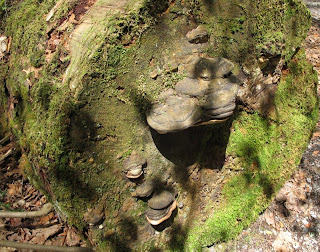The second day of the Wildflower Pilgrimage I joined Sue Studler for the "Hand lens exploration of trees, ferns, and mosses of Cathedral". Heather Griscom was also there to tell us about the Hemlocks and how they were doing everything to save them from the hemlock woolly adelgid (Adelges tsugae). As a home owner when my trees were infected by woolly adelgid I just sprayed them with insecidal soap and that solved the problem for a while until the trees became too tall. So you can imagine the problem of saving these giants. Here they are injecting them with something to kill or at least delay the destruction. Each tree has at least one or two tags to help monitor it's care.
Cathedral's old growth forest makes it one of my favorites parks in West Virginia. It almost seems magical at times, and to spend the day looking at moss and other tiny things with an expert brylogist like Dr. Studler, well I couldn't been happier. Cathedral State Park is an ancient hemlock forest and one of the reminders of how the forest of West Virginia looked before logging took down most of the trees. It is now the only remaining stand of virgin hardwood forest in West Virginia.
Part of the preservation and management of this forest is to let trees fall and rot naturally. Trees are only cleared if they are blocking a trail or danger to visitors. So it has the look of a very untidy forest which is part of its charm. Here is one of the many "nursery logs" we passed on our walks in the 133 acres. A nursery log is on that has fallen to the ground and has been colonized by lichen, moss, ferns and eventually small trees.
As the trees grow and the logs decay a space is left where the nursery log once once. Below is an example of a tree that grew out of a nursery log. You can see how the roots once wrapped around the now decayed log.
More than 50 species of flowers have been catalogued in the park including these Bluets. I was surprised to see them because in my county they are long gone. I think this is the most I have ever seen in one location.
We walked out into this meadow to find more surprises
like the crayfish holes
and teaberry leaves. I love to pick a leaf and chew on it because it brings back memories of Teaberry Chewing Gum that is so hard to find now. There is just no other taste quite like it.
Back into the forested area
and a walk along the stream
led to this Artist's Conk (Ganoderma applanatum). It is a very large pollypore, sometimes 20 inches or more, that can be flipped over and carved on the lower surface like sailors used to carve on ivory. This one is about 15 inches wide.
Here is a Two-leaf Toothwort (Cardamine diphylla).
I spent most of the day looking down and through a hand lens and then looking straight up at the tall hemlocks. They were so tall it was difficult to take it all in. There are around 30 plus species of trees here with the Hemlock (Tsuga canadensis) dominating.
Treautalas boraalias (Star Flower)
Here is one of the other participants standing next to this hugh Wild Black Cherry tree (Prunus serotina). If it hadn't been pointed out to us I certainly wouldn't have guessed it was a Cherry Tree.
These are the delicate flowers of a Striped Maple.
I have seen maple keys but never noticed the flowers before.
My photo of the largest Hemlock at Cathedral doesn't even begin to capture the size. You almost have to lay on your back to see the top without falling over backwards.
One thing I found interesting about them is the way they are twisted on the inside. The outside looks perfectly normal but when they bark is shed you can see how they are twisted. No one was really able to give us a good explanation of why that happens.
So that is the big over view of the park and my day there. The next post will be about the moss and those tiny things we saw through the hand lens.
Click here to visit other interesting places on Scenic Sunday.

IMG_6593.JPG)


+IMG_6736.JPG)


++IMG_6766.JPG)


+diphylla+(Two+leaved+toothwort)+IMG_6870.JPG)

+IMG_6584.JPG)







+DSCN5800+for+blog.jpg)

7 comments:
Such a thick and beautiful old forest.
Ponderosa Pines often grow spiraled because of shallow spreading roots and nutrients are better distributed than straight grain.
Gaelyn, I wonder if that is the case here. The roots of the Hemlock in this park also shallow. Thanks.
So interesting to see these.
Looks just the place for a country ramble. Many interesting things you've shown us.
Cheers.
Melbourne Daily Photo
this is such an amazing post, thank you for all this wonderful information. It sure sounds and looks as though you had a wonderful time. Oh to teaberry gum, I never thought of there being an actually teaberry plant!
A fascinating old forest! I really enjoyed this journey with you!
I love the wild flowers. Do you walk in the forest often?
Post a Comment